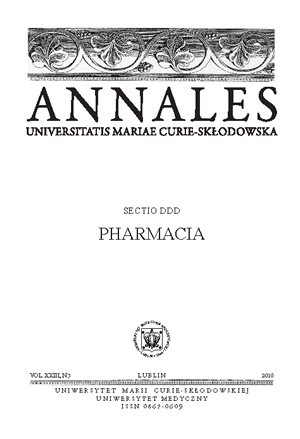sVCAM-1 levels in patients with type 2 diabetes mellitus with micro- and macrovascular complications.
Keywords:
diabetes, microangiopathy, macroangiopathy, sVCAM-1, cardiovascular complicationsAbstract
In the course of prolonged hyperglycemia changes similar to chronic inflammation occur in the organism, with increased phagocytic cell transition (neutrophils, monocytes) by the endothelium towards sites of inflammation. Important role in these processes play some of the protein structures found on the cell surface which serve to allow interaction among cells and between cells and the extracellular matrix. Those molecules are called adhesion molecules (cell adhesion molecules - CAM). Therefore, the aim of this study was to evaluate the concentration of soluble vascular cell adhesion molecules (sVCAM) in serum of patients with type 2 diabetes with associated micro-and macro-vascular complications.
The highest median of sVCAM-1 levels were found in patients with diabetes who showed macrovascular complications. In this group, patients with myocardial infarct (919.6 ng/ml) and coronary heart disease (907.2 ng/ml) had significantly higher levels of sVCAM-1 compared with the group without complications.
Taking into account the available literature reports as well as the results obtained during this study we can conclude that the metabolic abnormalities characteristic for type 2 diabetes i.e. hyperglycemia, are the results of inflammation and may be responsible for its’ intensification.
Markers of inflammation as adhesion molecules may be useful predictive indicators of cardiovascular complications of diabetes. More studies are needed to understand the sequence of events leading to abnormal vascular function in subjects with type 2 diabetes.
References
1. Adamiec J., Oficjalska-Młyńczak J.: Rola molekuł adhezyjnych w rozwoju proliferacyjnej retinopatii cukrzycowej. Klin. Oczna, 107, 330, 2005.
2. Adamiec J., Oficjalska-Młyńczak J.: Udział wybranych molekuł adhezyjnych oraz cytokin pozapalnych w patogenezie proliferacyjnej retinopatii cukrzycowej. Przegl. Lek., 64, 389, 2007.
3. Drobniak-Hełdak D. et al.: Markery stanu zapalnego u chorych ze stabilną chorobą niedokrwienną serca leczonych przezskórną angioplastyką naczyń wieńcowych. Kard. Pol., 63, 228, 2005.
4. Fal A.M. et al.: Rola cząsteczek adhezyjnych w patofizjologii procesów chorobowych-perspektywy terapeutyczne. Pol. Arch. Med. Wewn., 1, 765, 2003.
5. Fedorowicz A., Chłopicki S.: Farmakologia śródbłonka w nadciśnieniu płucnym. Kardiol. Pol., 63, 462, 2005.
6. Gulińska A. i wsp.: Ocena wybranych markerów uszkodzenia śródbłonka u chorych z cukrzycą typu 1 leczonych - od momentu rozpoznania choroby - metodą intensywnej czynnościowej terapii. Nowiny Lek., 70, 103, 2001.
7. Jarosz A., Nowicka G.: Stężenie molekuł adhezyjnych ICAM-1 i VCAM-1 w surowicy krwi mężczyzn. Czyn. Ryz., 1, 5, 2008.
8. Kolcowa O. et al.: Ocena wybranych markerów procesu zapalnego u chorych na cukrzycę typu 2. Diab. Dosw. Klin., 3, 41, 2003.
9. Ley K.: Molecular mechanisms of leukocyte recruitment in the inflammatory process. Cardiovasc. Res., 32, 733, 1996.
10. Maśliński S., Ryżewski J.: Patofizjologia. Podręcznik dla studentów medycyny. PZWL, Warszawa 2002.
11. Otsuki M. i wsp.: Circulating vascular cell adhesion molecule-1 (VCAM-1) in atherosclerotic NIDDM patients. Diabetes, 46, 2096, 1997.
12. O’Brien K.D. et al.: Vascular cell adhesion molecule-1 is expressed in human coronary atherosclerotic plaques. Implications for the mode of progression of advanced coronary atherosclerosis. J. Clin. Invest., 92, 945, 1993.
13. Wieliczko M. et al.: Związek pomiędzy markerami stanu zapalnego a miażdżycą tętnic szyjnych i zdarzeniami sercowo-naczyniowymi u chorych przewlekle hemodializowanych. Nefrol. Dial. Pol., 10, 21, 2006.
14. Wierusz-Wysocka B., Zozulińska D.: Rola molekuł adhezyjnych w patogenezie cukrzycy typu 1 oraz późnych powikłań schorzenia. Med. Metab., 41, 41, 1998.
15. Winiarska H. et al.: Aktywacja prozapalna monocytów krwi obwodowej u chorych na cukrzycę typu 2. Przegl Kardiodiabetol., 4, 125, 2009.
16. Wojtczak A.: Choroby wewnętrzne. PZWL Warszawa 1995.
17. Zaporska-Downar D.: Dysfunkcja komórek śródbłonka jako jeden z czynników patogenetycznych miażdżycy. Normalizujący wpływ niektórych leków. Czyn. Ryz., 4, 5, 2000.
18. Zaremba J., Losy J.: Cytokiny w klinicznym i doświadczalnym udarze niedokrwiennym mózgu. Neurol. Neuroch. Pol., 38, 57, 2004.
19. Zozulińska D., Majchrzak A.: Znaczenie argininy w patologii przewlekłych powikłań cukrzycy. Diabetol. Dosw. Klin., 4, 331, 2004.
Downloads
Published
Issue
Section
License
Copyright (c) 2010 Authors

This work is licensed under a Creative Commons Attribution-NonCommercial-NoDerivatives 3.0 Unported License.


